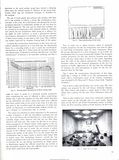



In planning the remodeling of the local RCA scoring stage, special consideration was given to the preference among musicians and music-lovers for rooms which contain a large amount of wood paneling. This preference can be attributed largely to the ability of such a material to vibrate over a wide range of musical pitch, unlike a panel of plaster or fiber board. The energy employed to set the wood sheet into vibration is partly re-radiated in a manner that does not follow the regular law of equal angle of incidence and reflection. A vibrating surface, because of its size and shape, may therefore emit plane or cylindrical waves, although it is excited by spherical waves. In this sense, the walls of the band shell may also be considered to be an extension of the instruments – an extension which, although loosely coupled to the sources of sound, nevertheless emphasizes many of the frequency components of music sufficiently to lend pleasant support to the music. It is the sounding board again – a device that magnifies the tonal area of the instrument by creating sustaining surface sources in proximity to a relative point-source or sources.
[…]
Several other studios have lately been constructed employing convex splays on the sidewalls with very good results. Among these are the WFAA and KGKO broadcasting studios in Dallas, Texas, the RCA recording studio in South America, the RCA film recording studios in New York, and the Walt Disney scoring stage. The only undesirable feature in these rooms, including this stage, is presented by the comparatively large expanse of the flat floor. However, the use of players' platforms, chairs in the room, and the judicious use of rugs does much to ameliorate this condition.
[…]